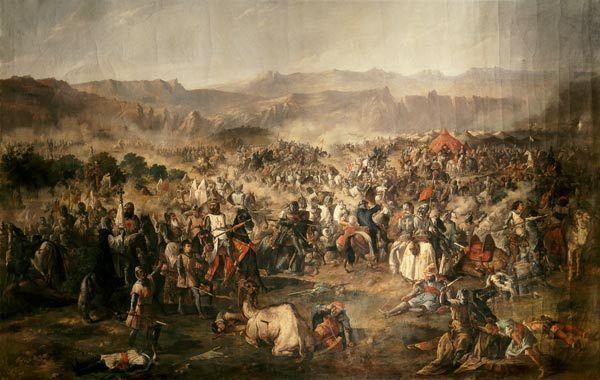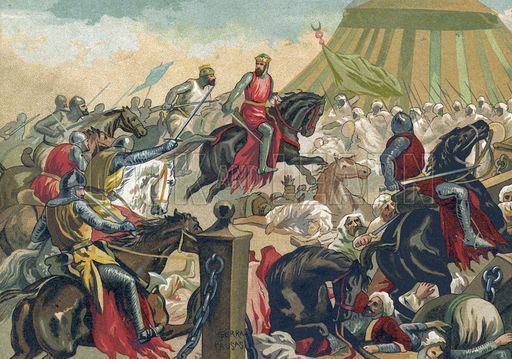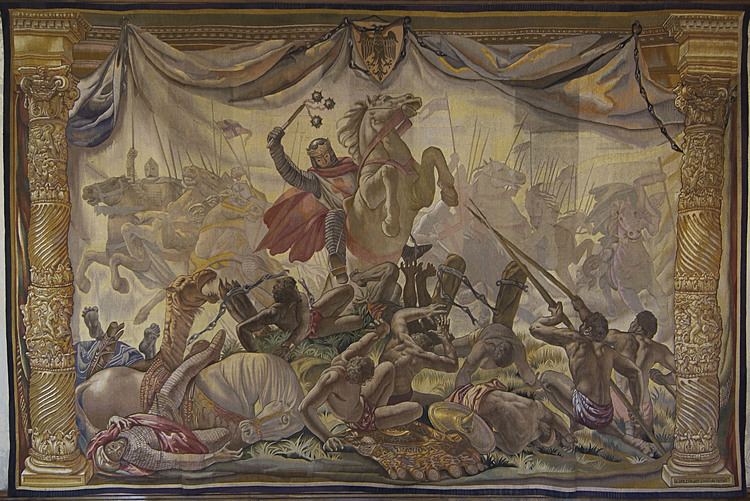12,000–14,000 ~22,000–30,000 Date 16 July 1212 | unknown very high | |
 | ||
Result Decisive Christian victory Combatants Kingdom of Castile, Crown of Aragon, Kingdom of Portugal Similar Battle of Alarcos, Battle of Sagrajas, Battle of Guadalete, Battle of Covadonga, Umayyad conquest of Hispania | ||
The Battle of Las Navas de Tolosa, known in Arab history as the Battle of Al-Uqab (معركة العقاب), took place on 16 July 1212 and was an important turning point in the Reconquista and in the medieval history of Spain. The Christian forces of King Alfonso VIII of Castile were joined by the armies of his rivals, Sancho VII of Navarre, Peter II of Aragon and Afonso II of Portugal, in battle against the Berber Almohad Muslim rulers of the southern half of the Iberian Peninsula. The Caliph al-Nasir (Miramamolín in the Spanish chronicles) led the Almohad army, made up of people from the whole Almohad empire. Most of the men in the Almohad army came from the African side of the empire.
Contents
- Battle of las navas de tolosa july 16 1212 reconquista
- Background
- Previous movements
- Battle
- Aftermath
- Moorish Granada
- In fiction
- References

Battle of las navas de tolosa july 16 1212 reconquista
Background

In 1195, Alfonso VIII of Castile was defeated by the Almohads in the so-called Disaster of Alarcos. After this victory the Almohads took several important cities: Trujillo, Plasencia, Talavera, Cuenca, and Uclés. Then, in 1211, Muhammad al-Nasir crossed the Strait of Gibraltar with a powerful army, invaded Christian territory, and captured Salvatierra Castle, the stronghold of the knights of the Order of Calatrava. The threat to the Hispanic Christian kingdoms was so great that Pope Innocent III called European knights to a crusade.
Previous movements

There were some disagreements among the members of the Christian coalition: French and other European knights did not agree with Alfonso's merciful treatment of Jews and Muslims that were previously defeated in the conquest of Malagón and Calatrava la Vieja. Previously, they had caused problems in Toledo, (where the different armies of the Crusade gathered), with assaults and murders in the Jewish Quarter. More than 30,000 men deserted and returned to their homes across the Pyrenees.
Battle

Alfonso crossed the mountain range that defended the Almohad camp, sneaking through the Despeñaperros Pass, being led by Martin Alhaja, a local shepherd that knew the area. The Christian coalition caught the Moorish army at camp by surprise, and Alhaja was granted the hereditary title Cabeza de Vaca for his assistance to Alfonso VIII.
According to legend, the Caliph had his tent surrounded with a bodyguard of slave-warriors who were chained together as a defense. The Navarrese force led by their king Sancho VII broke through this bodyguard. The Caliph escaped, but the Moors were routed, leaving heavy casualties on the battlefield. The victorious Christians seized several prizes of war: Miramamolín's tent and standard were delivered to Pope Innocent III.
Christian losses were far fewer, only about 2,000 men (though not as few as legend had it). The losses were particularly heavy among the Orders. Those killed included Pedro Gómez de Acevedo (bannerman of the Order of Calatrava), Alvaro Fernández de Valladares (comendator of the Order of Santiago), Pedro Arias (master of the Order of Santiago, died of wounds on 3 August) and Gomes Ramires (Portuguese master of the Knights Templar and simultaneously master of Leon, Castile and Portugal). Ruy Díaz (master of the Order of Calatrava) was so grievously wounded that he had to resign his command.
The Caliph Muhammad al-Nasir himself died in Marrakech shortly after the battle, where he had fled after the defeat.
Aftermath
The crushing defeat of the Almohads significantly hastened their decline both in the Iberian Peninsula and in the Maghreb a decade later. That gave further impulse to the Christian Reconquest and sharply reduced the already declining power of the Moors in Iberia. Shortly after the battle, the Castilians took Baeza and then Úbeda, major fortified cities near the battlefield and gateways to invade Andalusia. Thereafter, Alfonso VIII's grandson Ferdinand III of Castile took Cordova in 1236, Jaén in 1246, and Seville in 1248; then he took Arcos, Medina-Sidonia, Jerez, and Cadiz. In 1252, Ferdinand was preparing his fleet and army for invasion of the Almohad lands in Africa. But he died in Seville on 30 May 1252, during an outbreak of plague in southern Hispania. Only Ferdinand's death prevented the Castilians from taking the war to the Almohad On the Mediterranean coast, James I of Aragon conquered the Balearic Islands (from 1228 over the following four years) and Valencia (the city capitulated on 28 September 1238).
By 1252 the Almohad empire was almost over, at the mercy of another emerging African power. In 1269 a new association of African tribes, the Marinids, took control of the Maghreb, and most of the former Almohad empire was under their rule. Later, the Marinids tried to recover the former Almohad territories in Iberia, but they were definitively defeated by Alfonso XI of Castile and Afonso IV of Portugal in the Battle of Río Salado, the last major military encounter between large Christian and Muslim armies in Hispania.
Moorish Granada
In 1292 Sancho IV took Tarifa (the city resisted a siege in 1294), key to the control of the Strait of Gibraltar. Granada, Almería, and Málaga were the only major Muslim cities of the time remaining in the Iberian peninsula. These three cities were the core of the Emirate of Granada, ruled by the Nasrid dynasty. Granada was a vassal state of Castile, until finally taken by the Catholic Monarchs in 1492.
In fiction
Harry Harrison's 1972 alternate history/science fiction novel Tunnel Through the Deeps depicts a history where the Moors won at Las Navas de Tolosa and retained part of Spain into the 20th century.
